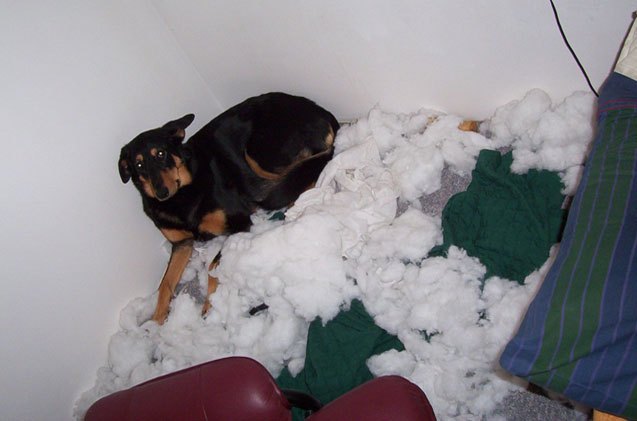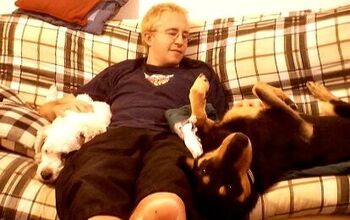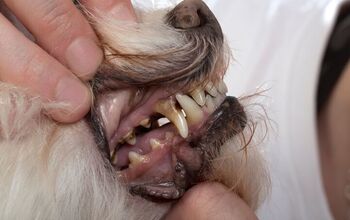Why I Believe Dog Adoption Takes More Than Heart: Part Two

Following my heart, I brought a feral dog home from the shelter.
I brought her home, even though this dog was not used to life in the city.
I brought her home, even though this dog was scared and terrified of people.
I brought her home, even though she had never set foot in a house.
I had made a decision with my heart. Love would heal all. I was sure of it. Right?!?
Her name was Willow – strong, graceful and able to weather any storm. My heart was swelling.
As soon as we got home, there were problems. I pulled into the garage, parked, and opened the car door. Willow had spent the ride home crouched on the back floor, drooling and panting hysterically. I opened the car door, and she just lay there, too scared to move.
I tried to gently coax her out with the leash, with food, another dog, with the sound of my voice – nothing worked. I gave her time, and more time. I really underestimated how much time a feral dog needs. Four long hours later, she crawled out into the yard. We were over the first hurdle!
Or so I thought.
Once in the yard, she crashed around, eyes wide. She leapt and sped throughout the gardens, knocking patio furniture over. When she would reach a corner of the yard, she would alternatively dig at the corner and scramble against the fence. Eyes wide, claws digging into the fence boards. She wouldn’t let me touch her, she ran from the other dogs. Food wasn’t a temptation. This dog was terrified.
Related: Why I Believe Dog Adoption Takes More Than Heart: Part 1
But I was confident that love would fix her. I had opened my heart to her, and was committed to helping her, to rescuing her. But the problem was, she didn’t love me. She wanted nothing to do with me. Born feral, she had no contact with people for the first three years of her life. She didn’t want anything to do with me.
Three days later, I was finally able to get Willow into the house. Three days of crashing and running around in the yard. Thankfully, she took readily to crate training. In fact, she loved the crate so much that she often refused to come out at all. Day after day, I would put her food in front of her crate, leaving the door open. She would eat it, but only if I was not in the room.
This is the point where my heart had taken me. And my heart was heavy with grief and guilt. I wanted to rescue this dog. But my head told me that I lacked the skills and love was not enough. I called a trainer for some professional advice.
Related: Why You Should Consider Fostering a Dog
When the trainer arrived at the appointed time, I opened the front door, holding out my hand for a handshake. Instead I was greeted by bacon. Flying bacon. The trainer was standing there on my steps tossing bacon about my house.
Willow bolted into her kennel. Shaking, eyes wide, she refused to turn her head towards this stranger. Her whole body was trembling. The trainer was patient, and came every second day for two months. Each time the same routine was followed. Bacon flew through the air like confetti, and Willow hid in her kennel until the trainer left. After two months of this, my house stunk like bacon and Willow still was unable to leave her kennel when the trainer was there. Things weren’t getting any better.
It was time to try a different trainer. During our phone interview, I went over all the things that caused Willow fear. We were okay walking early in the morning, when there was little traffic on the roads and no people about. If she encountered people on a walk, she would begin to tremble and shake, her eyes would go wide, and she would try to pull frantically away. Sometimes she would duck under a parked car, and I would have to crawl down and get her out.
The trainer suggested that we take her out and confront her fears head on. We loaded into her van, and looked to confront Willow’s greatest fears. After a few minutes of driving we came upon it, the perfect storm. There was a child, on a tricycle – a happy kid pedaling away, streamers waving in the wind. For Willow, this was the single most terrifying thing in the world. Would she conquer her fears?
The trainer pulled the van over to the curb, opened the side door, and jumped out with Willow. They began to run, Willow wasn’t sure what was going on, but she ran, and ran until Willow saw the child coming down the sidewalk.
At the exact moment that Willow saw the child, the child saw her. They both let out a shriek and put on the brakes. The trainer dragged Willow towards the child, and gave her a kick to keep her moving. I ran ahead, grabbed the leash, and fired the trainer on the spot. My heart and my head told me that it was going to be difficult to find a trainer equipped to deal with Willows needs.
Eventually, Willow started to trust me. After three years she accepted the first treat from my hand. Four years later she discovered the couch, and would happily lie on it next to me. Five years in, she began to show herself when friends came over, even lettering some of them touch her.
I made many changes to my life to accommodate her needs, we replaced walks in the city for longer hikes in the country. Her anxiety was lessened when there was another dog with around, so I always made sure I had at least two dogs. She was less terrified in the car in a crate. Canada Day fireworks terrified her so badly she couldn’t go in the yard for days – so we would go deep in the bush every Canada Day to give her peace.
Some doggy things she just didn’t do. She never played fetch with a ball or a stick; in fact she wasn’t ever really one for toys. She never learned to eat standing up. She always crouched and often lay down to eat in her kennel.
Dog people, with huge hearts, would go to pet her, but she was terrified of their touch. People asked if she had been abused, but she had never felt a cruel hand. It was a case of being born feral, socialized too late with people.
Managing her stress and fears was constant. I constantly managed her stresses with the help of a veterinary behaviorist. For Willow, there were never play dates in the park with other dogs, or walks for ice cream on a nice summer day. She was never able to enter the yard alone, enjoy the sun on the deck or play fetch. I worked hard to give her a quality of life.
It was my heart that decided to bring Willow home. But, it took all my heart and my head to manage her and give her a quality of life that she deserved. I had Willow for 12 years; she lived to be over 15 and died in my arms. With her last breath, I felt a tremendous sense of grief, but also of relief. She finally was at peace.
Looking back, having Willow in my life was a transformative experience. She pushed the limits of my patience and taught me to view the world in a different way. I had to be my utmost creative and a constant advocate for her. Walks were nocturnal, and never relaxing!
She was in tune to the natural world in a way that none of my other dogs ever have been. I was on constant guard for anything that might set her off. A loud car, a bike, a plastic bag that might blow in the wind. I was always ready to reassure her and move her fast her fears.
Now, when I come across a dog with high needs, I think back to my time with Willow. Bringing her home was a decision I made with my heart. Through the years, we faced many challenges together. Would I ever adopt a dog with such high needs again? You bet, but next time, it will be a decision I make with my head, not my heart.

Kevin Roberts lives for adventure. Together with his pack of rescue dogs and his husband, he spends as much time outdoors as possible. Kevin lives by the motto: "Get outside and play with your dogs!
More by Kevin Roberts



























